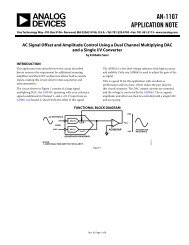Sailesh Chittipeddi - EEWeb
Sailesh Chittipeddi - EEWeb
Sailesh Chittipeddi - EEWeb
You also want an ePaper? Increase the reach of your titles
YUMPU automatically turns print PDFs into web optimized ePapers that Google loves.
Most design references assume the gain of 1 design<br />
is most advantageous for amplifier bandwidth and<br />
sensitivity reasons. However, it turns out this conditions<br />
always requires that R11) – and sometimes<br />
significantly less. Sweeping the C ratio from about 0.2 to<br />
5 for a gain of 1 and plotting the R2/R1 ratio for different<br />
target Q’s gives Figure 8. It is desirable that this ratio<br />
be low. Using equal C gives the minimum but as the<br />
required Qp goes up, R1 must be much lower than R2<br />
as shown in the log/log plot of Figure 8.<br />
R2/R1 Ratio<br />
Figure 8: Required R2/R1 ratio for swept C2/C1 parametric<br />
on Q using K=1.<br />
Getting some of the Q with gain in the amplifier has<br />
a dramatic effect on this in a desirable direction.<br />
Using an amplifier gain of 2 and repeating this same<br />
calculation gives the required R2/R1 ratio of Figure 9.<br />
Using just a bit of gain has moved the required R1 value<br />
up significantly if R2 is chosen for loading, noise, and<br />
input offset voltage reasons. These curves also suggest<br />
selecting C2/C1>1 might be desirable.<br />
R2/R1 Ratio<br />
1000<br />
100<br />
10<br />
10<br />
1<br />
R2/R1 Ratio vs C2/C1 Ratio K=1<br />
Q=.577 Q=.707 Q=1 Q=5.27<br />
1<br />
0.1 1 10<br />
C2/C1 Ratio<br />
R2/R1 Ratio vs C2/C1 Ratio K=2<br />
Q=.577 Q=.707 Q=1 Q=5.27<br />
0.1<br />
0.1 1 10<br />
C2/C1 Ratio<br />
Figure 9: Required R2/R1 ratio for swept C2/C1 parametric<br />
on Q using K=2.<br />
Using these two gains of 1 and 2, the difference in input<br />
impedance will be shown for a Q = 5.27 design (this<br />
is the approximate highest Q stage required for a 6th<br />
order 0.25dB Chebychev filter).<br />
TECH ARTICLE<br />
Example design for 1kHz 2nd order high<br />
pass with >1Mhz signal bandwidth for<br />
K=1<br />
The lowest R2/R1 ratio in figure 2 is for equal C at K=1.<br />
Use the ISL28113 (ref.3) to get a signal bandwidth<br />
exceeding 1Mhz in a μPower design as shown in the<br />
circuit of figure 4 (ref.4). This device offers a 2MHz Gain<br />
Bandwidth Product (GBP) using only 90μA (typical,<br />
130μA max) supply current on a 1.8V to 5.5V supply.<br />
Use an R2 that adds an input noise approximately equal<br />
to the amplifier’s 25nV/√Hz and start the design with<br />
R2=50kΩ. This high Q design will be peaking the input<br />
noise around Fo quite a lot, so it is best to not let R2 get<br />
too high. The design of Figure 4 used 50k for R2, but that<br />
forced R1 down to 457Ω using Eq. 4.<br />
Vin<br />
33.3n<br />
C 1<br />
33.3n<br />
C 2<br />
1.25u<br />
Figure 10: High Q, K=1 design with 1kHz Fo and<br />
Q = 5.27<br />
Figure 11 shows the expected frequency response<br />
while Figure 12 shows the relatively high noise peaking<br />
around Fo. The response curve is showing the expected<br />
peaking at 1kHz, and then a gain of 1 over a broad<br />
passband with the amplifier rolling off above 2Mhz.<br />
The output spot noise peaks approximately 60X around<br />
Fo. This is common for high Q stages but is even higher<br />
here due to the very high resistor ratio. Since this is<br />
happening at lower frequencies it should not impact the<br />
integrated noise too much, but will be degrading the<br />
loop gain at the lower end of the intended passband.<br />
Reducing this noise gain peaking for high Q poles is<br />
desirable and easily achieved by adding some gain in<br />
the amplifier.<br />
The added concern in Figure 10 is the several regions of<br />
capacitive input impedance. Figure 13 shows simulated<br />
input impedance showing the initial capacitive response<br />
up to Fo which then recovers to the R2 resistor value.<br />
The phase response across the R1 resistor comes down<br />
to approximately 0deg above Fo over a wide frequency<br />
range effectively bootstrapping out the relatively low R1<br />
value. However, even a slight phase deviation over the<br />
457<br />
R 2<br />
50k<br />
20<br />
Rb ISL28113<br />
+<br />
+<br />
–<br />
–<br />
Visit www.eeweb.com<br />
R 1<br />
10k<br />
R f<br />
V+<br />
V–<br />
-9.29209u<br />
19















